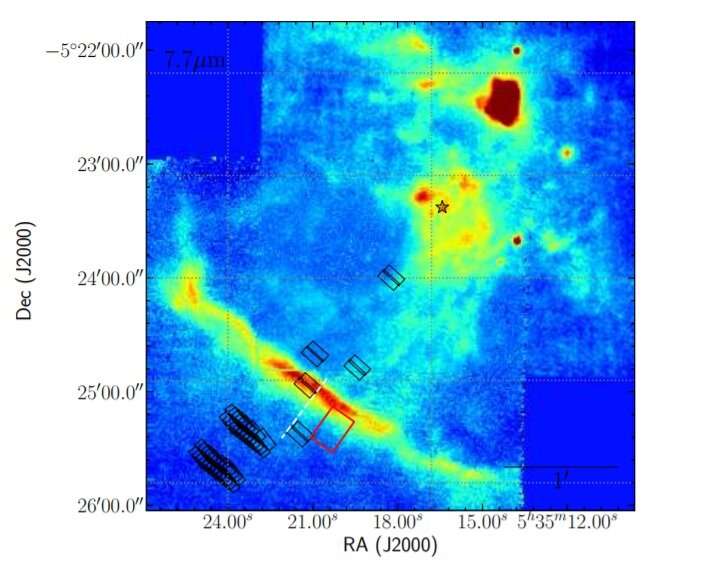November 18, 2021 report
Orion Bar region investigated in detail by Russian astronomers

Using spacecraft and ground-based facilities, Russian astronomers have inspected the Orion Bar photodissociation region, focusing on the mid-infrared emission from this source. Results of the study could help astronomers to better understand the evolution of polycyclic aromatic hydrocarbons in space. The research was published November 10 on arXiv.org.
At a distance of about 1,300 light years away, the Orion Nebula is the nearest region of massive star formation to Earth, with a complex and extensive gas structure. It hosts the so-called "Orion Bar"—a ridge-like feature of gas and dust formed by the intense radiation from nearby, hot, young stars, which appears to be shaped like a bar.
The Orion Bar is a photodissociation region or photon-dominated region (PDR). In general, PDRs are regions in the interstellar medium (ISM) at the interface between hot ionized gas and cool molecular gas that are energetically dominated by non-ionizing ultraviolet photons.
Given that the Orion Bar is a bright and nearby PDR with simple geometry it could serve as an ideal laboratory to inspect the life-cycle of polycyclic aromatic hydrocarbons (PAHs) and other small carbonaceous grains, as their evolution strongly depends on the ultraviolet field. So far, wide PAH emission bands have been detected in the Orion Bar, and astronomers generally assume that the observed strong mid-infrared emission in the ISM is associated with PAHs.
That is why a team of astronomers led by Maria S. Murga of the Institute of Astronomy of the Russian Academy of Sciences, decided to investigate the mid-infrared emission in the Orion Bar by analyzing the archival photometric and spectroscopic observations of this region.
"We investigate the mid-infrared (IR) emission in the Orion Bar photodissociation region, using archival photometric and spectroscopic observations from UKIRT, Spitzer, ISO, and SOFIA telescopes. Specifically, we consider flux densities of the emission bands at 3.3, 3.4, 3.6, 6.6, 7.7, 11.2 µm in several locations and a spectrum from 3 to 45 µm in one location," the researchers wrote in the paper.
Murga's team modeled the PAH photo-destruction under a harsh ultraviolet field, and considered different limits on the PAH size, above which the loss of carbon is forbidden, assuming unrestricted loss of hydrogen. They also considered the case when no PAH evolution occurs in the Orion Bar.
The astronomers managed to calculate the size, hydrogenation state and charge distributions for PAHs in different positions through the Orion Bar, and used the results of the modeling to obtain simulated spectra and band intensities. Their modeling satisfactorily describes the variations of ratios of various band fluxes with the distance from the ionizing source.
The study found that carbon loss of PAHs in the Orion Bar is limited by the number of carbon atoms at a level of 60, and the band at 3.4 µm may indeed be attributed to PAHs with extra hydrogen atoms. The researchers concluded that large cations dominate at the surface of this PDR but small neutral PAHs and anions are abundant deeper in the molecular cloud.
More information: Maria S. Murga, Maria S. Kirsanova, Dmitry S. Wiebe, Paul A. Boley, Orion Bar as a window to the evolution of PAHs. arXiv:2111.05583v1 [astro-ph.GA], arxiv.org/abs/2111.05583
© 2021 Science X Network




















